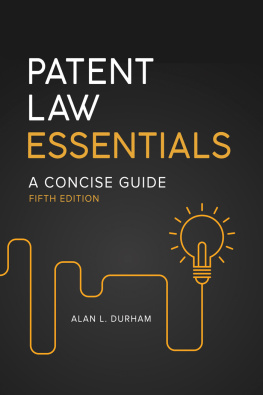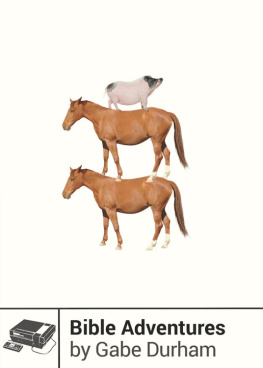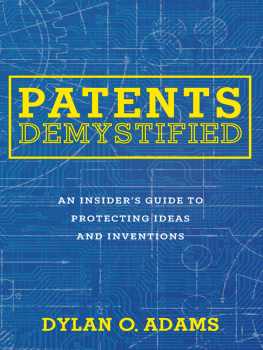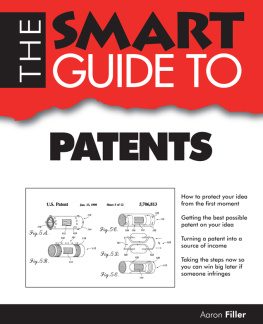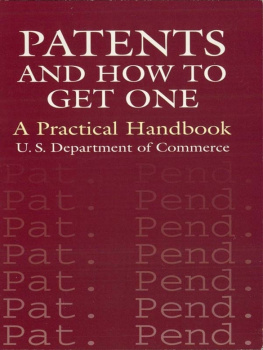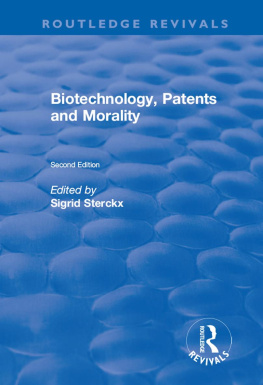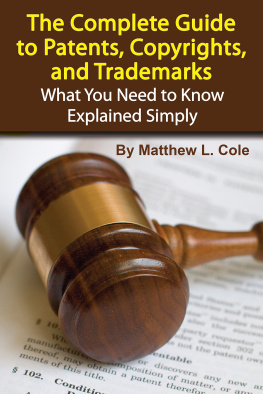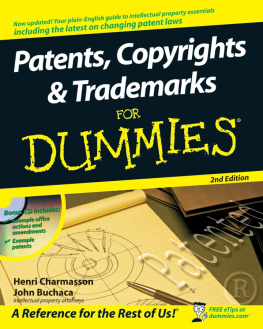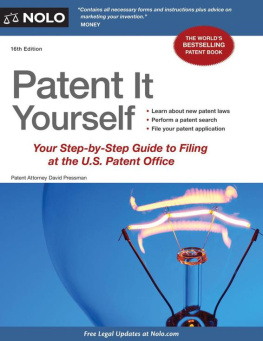Patent Law
Essentials
A Concise Guide
FIFTH EDITION
Alan L. Durham

Copyright 2018 by Alan L. Durham
All rights reserved. No part of this publication may be reproduced, stored in a retrieval system, or transmitted, in any form or by any means, electronic, mechanical, photocopying, recording, or otherwise, except for the inclusion of brief quotations in a review, without prior permission in writing from the publisher.
Library of Congress Cataloging-in-Publication Data
Names: Durham, Alan L., 1963- author.
Title: Patent law essentials : a concise guide / Alan L. Durham.
Description: [Fifth edition]. | Santa Barbara, California : Praeger, [2018] | Includes bibliographical references and index.
Identifiers: LCCN 2017044157 (print) | LCCN 2017044957 (ebook) | ISBN 9781440859892 (ebook) | ISBN 9781440859885 (hardcopy : alk. paper)
Subjects: LCSH: Patent laws and legislationUnited States.
Classification: LCC KF3114.85 (ebook) | LCC KF3114.85 .D87 2018 (print) | DDC 346.7304/86dc23
LC record available at https://lccn.loc.gov/2017044157
ISBN: 9781440859885 (print)
EISBN: 9781440859892 (ebook)
22 21 20 19 181 2 3 4 5
This book is also available as an eBook.
Praeger
An Imprint of ABC-CLIO, LLC
ABC-CLIO, LLC
130 Cremona Drive, P.O. Box 1911
Santa Barbara, California 93116-1911
www.abc-clio.com
This book is printed on acid-free paper 
Manufactured in the United States of America
For my wife, Laura, and my daughter, Madeline
Contents
Introduction
This book began with an expert witness. A preeminent authority in a specialized field of engineering, he had been hired to testify on the defendants behalf in a high-stakes patent infringement case. Like many people who find themselves confronting the arcane system of patent law for the first time, he wanted to know the rules of the game. At the time there were expansive resources for lawyers, generally in many volumes, and study aids directed at law students, but no books I could recommend offering the right mixture of sophistication and simplicity. If there were such a book, I thought, I could use it myself. As an attorney in the field, I knew the standard rules of patent law, but I did not always have at my fingertips recent authorities to support them. Those authorities had to be sought out in the multivolume treatises or the indexed case reportersa time-consuming chore simply because they included so much material. I determined to write for myself a concise book on patent law that could serve either purpose. It would be accessible enough, I hoped, to introduce nonlawyers to the rules of the game while being sophisticated enough to provide attorneys a useful desk referencea starting place, at least, for further research. This book, now in its fifth edition, is the result of that ambition. I have been pleased to learn that not only attorneys and engineers have found it useful but also business people, judges, patent examiners, professors, and law studentssome of whom have contacted me with encouraging feedback. I thank them all.
One of the special challenges in understanding patent law is that it is always changing. This can happen through new legislation, like the LeahySmith America Invents Act (AIA) of 2011. The AIA recast our system of patent law from one that generally awards priority based on the date of invention to one that favors the first inventor file a patent application. Now the inventor who first imagines the better mousetrap may lose out to the inventor who first tries to patent it. Even when the statute remains the same, its interpretation can shift overnight. This happens with uncommon frequency in patent law because a single courtthe Federal Circuit Court of Appealsdecides nearly all patent cases at the appellate level. Those decisions, in turn, are subject to review by the United States Supreme Court, and in recent years the Supreme Court has intervened on more than one occasion to abrogate the rules worked out by the Federal Circuit. Other areas of the law change incrementally; patent law, for better or worse, can change dramatically.
The most far-reaching changes of recent times concern a foundational question: what sort of discovery can be patented? Is a discovery in the field of microbiology that leads to improved medical treatments a patentable invention, or is it a natural phenomenon? Is a system of organizing data that lends a computer new capabilities a patentable invention, or is it an abstract idea? Such questions arise often in the fields of biotechnology and computer science, where innovation, and rewards for innovation, play a critical role. Thanks to recent decisions by the Supreme Court, we must approach these issues differently that we did before, and many patents that only a few years ago seemed exceedingly valuable are now plausible targets for invalidation. The line drawing is still in flux, and the effects of this change on the advancement of technology are yet to be seen. As I remarked in the introduction to the fourth editionwhen these changes had only begunthe stakes could not be higher. Intellectual property is one of the most valuable assets that a business can own, often deciding the balance of power in both the marketplace and the courtroom. These remain, for patent law, interesting times.
Once again, I thank my friends, colleagues, and students at the University of Alabama School of Law for their inspiration and encouragement. Former Dean Kenneth Randall and current Dean Mark Brandon have supplied critical and much-appreciated support for my research. I also thank my former colleagues at Morrison & Foerster and Brown & Bain, whose understanding and flexibility made the first edition of this book a reality. Finally, I thank inventor Bill Oviatt, whose ingenious Teeter Pong mousetrap I have used as example in this book and in many a Patent Law class.
CHAPTER 1
Overview
1.1 ORIGINS
The historical antecedents of the U.S. patent system are often traced to seventeenth-century England. Until then, a patent might refer to nothing more than a legally sanctioned monopoly, granted to reward a loyal subject or sold to raise funds for the government. A merchant guild, for example, might purchase a patent for the exclusive right to sell playing cards. Freedom from competition allowed the patent owner to sell in larger volumes and at a higher price. Undoubtedly popular with the government and with the patent owners, these odious monopolies were a source of resentment to consumers and potential competitors. In 1624, the Crown relented and the Statute of Monopolies, abolishing the general power of the monarch to grant exclusive rights, became law. Importantly, the statute ending the general practice of monopolies specifically exempted patents allowing inventors the exclusive right to their inventions.
The tradition of granting patents to inventors continued in colonial America and, in spite of some skepticism by influential thinkers such as Thomas Jefferson, it was incorporated in the laws of the United States. The framers of the Constitution provided to Congress, in Article I, The specifics were left to Congress and to the Patent and Trademark Office (also known as the Patent Office, or PTO), a division of the Department of Commerce created in 1836. The federal courts also have played a significant role in interpreting, supplementing, and perhaps, on some occasions, rewriting the rules set down by Congress.

